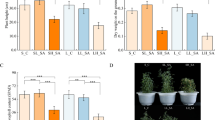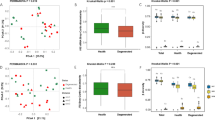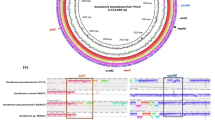Abstract
The occurrence and the distribution of rhizobial populations naturally associated to Acacia seyal Del. were characterized in 42 soils from Senegal. The diversity of rhizobial genotypes, as characterized by polymerase chain reaction restriction fragment length polymorphism (RFLP) analysis of 16S–23S rDNA, performed on DNA extracted from 138 nodules resulted in 15 clusters. Results indicated the widespread occurrence of compatible rhizobia associated to A. seyal in various ecogeographic areas. However, the clustering of rhizobial populations based on intergenic spacer (IGS) RFLP profiles did not reflect their geographic origin. Four genera were discriminated on the basis of 16S rRNA gene sequences of the strains representative for the IGS-RFLP profiles. The majority of rhizobia associated to A. seyal were affiliated to Mesorhizobium and Sinorhizobium 64 and 29%, respectively, of the different IGS-RFLP profiles. Our results demonstrate the coexistence inside the nodule of plant-pathogenic non-N2-fixing Agrobacterium and Burkholderia strains, which induced the formation of ineffective nodules, with symbiotic rhizobia. Nodulation was recorded in saline soils and/or at low pH values or in alkaline soils, suggesting adaptability of natural rhizobial populations to major ecological environmental stress and their ability to establish symbiotic associations within these soil environments. These results contribute to the progressing research efforts to uncover the biodiversity of rhizobia and to improve nitrogen fixation in agroforestry systems in sub-Saharan Africa.




Similar content being viewed by others
References
Allen, ON, Allen, EK (1981) The Leguminosae: A Source Book of Characteristics, Uses and Nodulation. The University of Wisconsin Press, Madison
Altschul, SF, Madden, TL, Schäffer, AA, Zhang, J, Zhang, Z, Miller, W, Lipman, DJ (1997) Gapped BLAST and PSI-BLAST: a new generation of protein database search programs. Nucleic Acids Res 25: 3389–3402
Ba, S, Willems, A, de Lajudie, P, Roche, P, Jeder, H, Quatrini, P, Neyra, M, Ferro, M, Prome, JC, Gillis, M, Boivin-Masson, C, Lorquin, J (2002) Symbiotic and taxonomic diversity of rhizobia isolated from Acacia tortilis subsp. raddiana in Africa. Syst Appl Microbiol 25: 130–145
Bala, A, Giller, KE (2001) Symbiotic specificity of tropical tree rhizobia for host legumes. New Phytol 149: 495–507
Bordeleau, LM, Prévost, D (1994) Nodulation and nitrogen fixation in extreme environments. Plant Soil 161: 115–125
Ben Romdhane, S, Nasr, H, Samba-Mbaye, R, Neyra, M, Ghorbal, MH (2005) Diversity of Acacia tortilis rhizobia revealed by PCR/RFLP on crushed root nodules in Tunisia. Ann Microbiol 55: 249–258
Ben Romdhane, S, Nasr, H, Samba-Mbaye, R, Neyra, M, Ghorbal, MH, de Lajudie, P (2006) Genetic diversity of Acacia tortilis ssp. raddiana rhizobia in Tunisia assessed by 16S and 16S–23S rDNA genes analysis. J Appl Microbiol 100: 436–445
Carter, JM, Gardner, WK, Gibson, AH (1994) Improved growth and yield of faba bean (Vicia faba cv. Fiord) by inoculation with strains of Rhizobium leguminosarum biovar viceae in acid soils in South-west Victoria. Aust J Agric Res 45: 613–623
de Lajudie, P, Willems, A, Nick, G, Moreau, F, Molouba, F, Hoste, B, Torck, U, Neyra, M, Collins, MD, Lindstorm, K, Dreyfus, B, Gillis, M (1998) Characterization of tropical tree rhizobia and description of Mesorhizobium plurifarium sp. nov. Int J Syst Bacteriol 48: 369–382
de Lajudie, P, Willems, A, Nick, G, Mohamed, SH, Torck, U, Coopman, R, Filali-Maltouf, A, Kersters, K, Dreyfus, B, Lindström, K, Gillis, M (1999) Agrobacterium bv.1 strains isolated from nodules of tropical legumes. Syst Appl Microbiol 22: 119–132
Diouf, D, Duponnois, R, Ba, AT, Neyra, M, Lesueur, D (2005) Symbiosis of Acacia auriculiformis and A. mangium with mycorrhizal fungi and Bradyrhizobium sp. improves salt tolerance in greenhouse conditions. Funct Plant Biol 32: 1143–1152
Diouf, D, Forestier, S, Neyra, M, Lesueur, D (2003) Optimization of inoculation of Leucaena leucocephala and Acacia mangium with rhizobium under greenhouse conditions. Ann For Sci 60: 1–6
Dolédec, S, Chessel, D (1987) Rythmes saisonniers et composantes stationnelles en milieu aquatique I-Description d’un plan d’observations complet par projection de variables. Acta Oecol 8: 403–426
Dommergues, YR (1995) Nitrogen fixation by trees in relation to soil nitrogen economy. Fert Res 42: 215–230
Don, RH, Cox, PT, Wainwright, BJ, Baker, K, Mattick, JS (1991) Touchdown PCR to circumvent spurious priming during gene amplification. Nucleic Acids Res 19: 4008
Doran, JC, Turnbull, JW (1997) Australian Trees and Shrubs: Species for Land Rehabilitation and Farm Planting in the Tropics. ACIAR Monograph No. 24. ACIAR, Canberra
Dreyfus, BL, Dommergues, YR (1981) Nodulation of Acacia species by fast and slow growing tropical strains of Rhizobium. Appl Environ Microbiol 41: 97–99
Felsenstein, J (1985) Confidence limits on phylogenies: an approach using the bootstrap. Evolution 39: 783–791
Gibson, AH (1980) Methods for legumes in glasshouses and controlled environment cabinets. In: Bergersen, FJ (Ed.) Methods for Evaluating Biological Nitrogen Fixation. Wiley-Interscience, Chichester, pp 139–184
Giri, B, Kapoor, R, Mukerji, KG (2003) Influence of arbuscular mycorrhizal fungi and salinity on growth, biomass, and mineral nutrition of Acacia auriculiformis. Biol Fertil Soils 38: 170–175
Hall, JB (1994) Acacia seyal—multipurpose tree of the Sahara desert. NFTA 94-07. FACT Net. Winrock International, Little Rock
Khbaya, B, Neyra, M, Normand, P, Zerhari, K, Filali-Maltouf, A (1998) Genetic diversity and phylogeny of rhizobia that nodulate Acacia spp. in Morocco assessed by analysis of rRNA genes. Appl Environ Microbiol 64: 4912–4917
Kimura, M (1980) A simple method for estimating evolutionary rates of base substitutions through comparative studies of nucleotide sequences. J Mol Evol 16: 111–120
Krasova-Wade, T, Ndoye, I, Braconnier, S, Sarr, B, de Lajudie, P, Neyra, M (2003) Diversity of indigeneous bradyrhizobia associated with three cowpea cultivars (Vigna unguiculata (L.) Walp.) grown under limited and favorable water conditions in Senegal (West Africa). Afr J Biotechnol 2: 13–22
Kwon, SW, Park, JY, Kim, JS, Kang, JW, Cho, YH, Lim, CK, Parker, MA, Lee, GB (2005) Phylogenetic analysis of the genera Bradyrhizobium, Mesorhizobium, Rhizobium and Sinorhizobium on the basis of 16S rRNA gene and internally transcribed spacer region sequences. Int J Syst Evol Microbiol 55: 263–270
Laguerre, G, Allard, MR, Revoy, F, Amarger, N (1994) Rapid identification of rhizobia by restriction fragment length polymorphism analysis of PCR-amplified 16S rRNA genes. Appl Environ Microbiol 60: 56–63
Mahler, RA, Bezdicek, DF (1978) Diversity of Rhizobium leguminosarum in the Palouse of eastern Washington. Appl Environ Microbiol 36: 780–782
Menna, P, Hungria, M, Barcellos, FG, Bangel, EV, Hess, PN, Martinez-Romero, E (2006) Molecular phylogeny based on the 16S rRNA gene of elite rhizobial strains used in Brazilian commercial inoculants. Syst Appl Microbiol 29: 315–332
Mhamdi, R, Laguerre, G, Aouani, ME, Mars, M, Amarger, N (2002) Different species and symbiotic genotypes of field rhizobia can nodulate Phaseolus vulgaris in Tunisian soils. FEMS Microbiol Ecol 41: 77–84
Mhamdi, R, Mrabet, M, Laguerre, G, Tiwari, R, Aouani, ME (2005) Colonization of Phaseolus vulgaris nodules by Agrobacterium-like strains. Can J Microbiol 51: 105–111
Mohammed, SH, Smouni, A, Neyra, M, Kharchaf, D, Filali-Maltouf, A (2000) Phenotypic characteristics of root-nodulating bacteria isolated from Acacia spp. grown in Libya. Plant Soil 224: 171–183
Moreira, FMS, Gillis, M, Pot, B, Kersters, K, Franco, AA (1993) Characterization of rhizobia isolated from different divergence groups of tropical Leguminosae by comparative polyacrylamide gel electrophoresis of their total proteins. Syst Appl Microbiol 16: 135–146
Mpepereki, S, Makonese, F, Wollum, AG (1997) Physiological characterization of indigenous rhizobia nodulating Vigna unguiculata in Zimbabwean soils. Symbiosis 22: 275–292
Ndoye, I, Gueye, M, Danso, SKA, Dreyfus, B (1995) Nitrogen fixation in Faidherbia albida, Acacia raddiana, Acacia senegal and Acacia seyal estimated using 15N isotope dilution technique. Plant Soil 172: 175–180
Normand, P, Cournoyer, B, Nazaret, S, Simonet, P (1992) Analysis of a ribosomal RNA operon in the actinomycete Frankia. Gene 111: 119–124
Normand, P, Ponsonnet, C, Nesme, X, Neyra, M, Simonet, P (1996) ITS analysis of prokariotes. In: Akkermans, ADL, van Elsas, JD, et De Bruijn, FJ (Eds.) Molecular Microbial Ecology Manual. Kluwer, Dordrecht
Odee, DW, Sutherland, JM, Makatiani, ET, McInroy, SG, Sprent, JI (1997) Phenotypic characteristics and composition of rhizobia associated with woody legumes growing in diverse Kenya conditions. Plant Soil 188: 65–75
Perriere, G, Gouy, M (1996) www-query: an on-line retrieval system for biological sequence banks. Biochimie 78: 364–369
Ponsonnet, C, Nesme, X (1994) Identification of Agrobacterium strains by PCR-RFLP analysis of pTi and chromosomal regions. Arch Microbiol 16: 300–309
Rouvier, C, Prin, Y, Reddell, P, Normand, P, Simonet, P (1996) Genetic diversity among Frankia strains nodulating members of the family Casuarinaceae in Australia revealed by PCR and restriction fragment length polymorphism analysis with crushed root nodules. Appl Environ Microbiol 62: 979–985
Saitou, N, Nei, M (1987) The neighbor-joining method: a new method for constructing phylogenetic trees. Mol Biol Evol 4: 406–425
Sarr, A, Neyra, M, Ould-Houeibib, MA, Ndoye, I, Oihabi, A, Lesueur, D (2005) Characterization of native rhizobial populations present in soils from natural forests of Acacia senegal and Acacia nilotica in Trarza and Gorgol regions from Mauritania and the Senegal River Valley. Microb Ecol 50: 152–162
Segovia, L, Pinero, D, Palacios, R, Martinez-Romero, E (1991) Genetic structure of a soil population of nonsymbiotic Rhizobium leguminosarum. Appl Environ Microbiol 57: 426–433
Singleton, PW, El-Swaifi, SA, Bohlool, BB (1982) Effect of salinity on Rhizobium growth and survival. Appl Environ Microbiol 44: 884–890
Sullivan, JT, Bertrand, DE, Van Berkum, P, Ronson, CW (1996) Four unnamed species of nonsymbiotic rhizobia isolated from the rhizosphere of Lotus corniculatus. Appl Environ Microbiol 62: 2818–2825
Sutherland, JM, Odee, DW, Muluvi, GM, Mcinroy, SG, Patel, A (2000) Single and multi-strain rhizobial inoculation of African acacias in nursery conditions. Soil Biol Biochem 32: 323–333
Sy, A, Giraud, E, Jourand, P, Garcia, N, Willems, A, de Lajudie, P, Prin, Y, Neyra, M, Gillis, M, Boivin-Masson, C, Dreyfus, B (2001) Methylotrophic Methylobacterium bacteria nodulate and fix nitrogen in symbiosis with legumes. J Bacteriol 183: 214–220
Thiao, M, Neyra, M, Isidore, E, Sylla, S, Lesueur, D (2004) Diversity and effectiveness of rhizobium from Gliricidia sepium native to Reunion Island, Kenya and New Caledonia. World J Microbiol 20: 703–709
Thioulouse, J, Chessel, D, Dolédec, S, Olivier, JM (1997) ADE-4: a multivariate analysis and graphical display software. Stat Comput 7: 75–83
Thompson, JD, Gibson, TJ, Plewniak, F, Jeanmougin, F, Higgins, DG (1997) The CLUSTAL X windows interface: flexible strategies multiple sequence alignment aided by quality analysis tools. Nucleic Acids Res 25: 4876–4882
Van Berkum, P, Fuhrmann, JJ (2000) Evolutionary relationships among the soybean bradyrhizobia reconstructed from 16S rRNA gene and internally transcribed spacer region sequence divergence. Int J Syst Evol Microbiol 50: 2165–2172
Vincent, JM (1970) A Manual for the Practical Study of Root-Nodule Bacteria. International Biological Programme. Handbook no. 15. Blackwell, Oxford
Von Maydel, LHJ (1983) Trees and Shrubs of the Sahel, their Characteristics and Uses. GTZ, Verlag Josef Margraf, Eschborn
Willems, A, Coopman, R, Gillis, M (2001) Comparison of sequence analysis of 16S–23S rDNA spacer regions, AFLP analysis and DNA–DNA hybridizations in Bradyrhizobium. Int J Syst Evol Microbiol 51: 623–632
Zakhia, F, de Lajudie, P (2001) Taxonomy of rhizobia. Agronomie 21: 569–576
Zakhia, F, Jeder, H, Willems, A, Gillis, M, Dreyfus, B, de Lajudie, P (2006) Diverse bacteria associated with root nodules of spontaneous legumes in tunisia and first report for nifH-like gene within the genera Microbacterium and Starkeya. Microb Ecol 51: 375–393
Zahran, HH (1999) Rhizobium-legume symbiosis and nitrogen fixation under severe conditions and in arid climate. Microb Mol Biol Rev 63: 968–989
Zeng, N (2003) Drought in the Sahel. Science 302: 999–1000
Zerhari, K, Aurag, J, Khbaya, B, Kharchaf, D, Filali-Maltouf, A (2000) Phenotypic characteristics of rhizobia isolates nodulating Acacia species in the arid and Saharan regions of Morocco. Lett Appl Microbiol 30: 351–357
Zhang, X, Harper, R, Karsisto, M, Lindström, K (1991) Diversity of Rhizobium bacteria isolated from the root nodules of leguminous trees. Int J Syst Bacteriol 41: 104–113
Acknowledgments
This work was supported by the Agence Universitaire de la Francophonie (PCSI project no. 6314PS512) and by the Institut de Recherche pour le Développement (Jeune Equipe Associée à l’IRD /Equipe de Recherche sur les Symbioses project). D. Diouf is indebted to IRD, France, for a fellowship “Bourse d’Echange Scientifique de Courte Durée.” The authors are grateful to Dr. C. Chaintreuil for technical help and Dr. Mayécor Diouf for discussions on statistical analyses.
Author information
Authors and Affiliations
Corresponding author
Rights and permissions
About this article
Cite this article
Diouf, D., Samba-Mbaye, R., Lesueur, D. et al. Genetic Diversity of Acacia seyal Del. Rhizobial Populations Indigenous to Senegalese Soils in Relation to Salinity and pH of the Sampling Sites. Microb Ecol 54, 553–566 (2007). https://doi.org/10.1007/s00248-007-9243-0
Received:
Revised:
Accepted:
Published:
Issue Date:
DOI: https://doi.org/10.1007/s00248-007-9243-0




